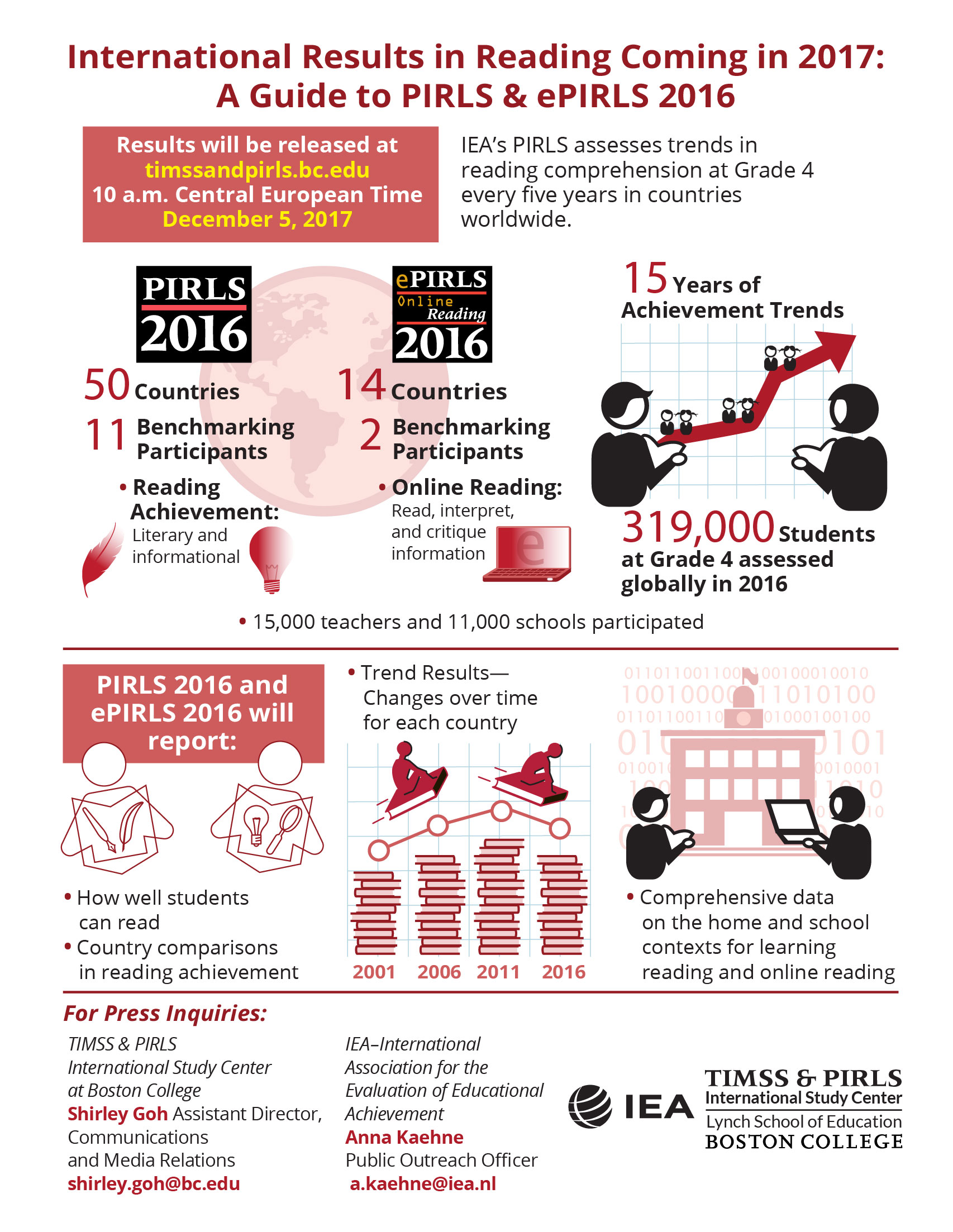Coming in December: Results of PIRLS 2016 and ePIRLS 2016
Whether you are new to PIRLS and ePIRLS or just looking ahead to their International Release in December 2017, here are some key facts and figures.

International Release
The results will be released on December 5, 2017, at 10 a.m. Central European Time at timssandpirls.bc.edu. They will include videos and infographics detailing major findings, as well as a video demonstrating ePIRLS 2016 test questions.
What are PIRLS and ePIRLS, and what do they do?
IEA’s PIRLS (Progress in International Reading Literacy Study) monitors trends in students’ reading achievement at the fourth grade every five years. PIRLS 2016 will report on 15 years of trends in reading achievement worldwide. Each cycle of the assessment provides extensive information about students’ home, school, and classroom contexts for learning in order to inform school improvement efforts.
ePIRLS is an extension of PIRLS that monitors how well fourth grade students read, interpret, and critique online information in an environment that looks and feels like the Internet. ePIRLS requires reading comprehension strategies that are assessed by PIRLS, but in an online context. Using a simulated Internet browser window, students conduct searches, navigate using links and tabs, and read texts to complete school-like assignments on history or science topics. ePIRLS 2016 is in its inaugural cycle.
How many countries and students participated in 2016?
PIRLS 2016 assessed 50 countries and 11 benchmarking participants, and ePIRLS 2016 assessed 14 countries and 2 benchmarking participants. PIRLS assessed 319,000 fourth grade students around the world in 2016, with participation from 15,000 teachers and 11,000 schools.
What PIRLS will Report
- Country comparisons in reading achievement
- Trend results over time for each country (for PIRLS only)
- Comprehensive data collected on the contexts for learning and teaching reading
- PIRLS and ePIRLS report achievement on a scale effectively ranging from 300 to 700, and they report the percentages of students who reach each PIRLS International Benchmark of Advanced, High, Intermediate, and Low
How do governments, education ministries, and researchers use PIRLS data?
- Measuring the effectiveness of educational systems in a global context
- Identifying gaps in learning resources and opportunities
- Pinpointing any areas of weakness and stimulating curriculum reform
- Measuring the impact of new educational initiatives
- Training researchers and teachers in assessment and evaluation
Why participate in PIRLS and ePIRLS?
PIRLS aims to help countries improve teaching reading and the learning of reading around the world. The assessment provides countries with rigorous and reliable data about students’ reading achievement at regular five-year intervals. Countries use PIRLS to make their own evidence-based decisions on how best to improve their education systems.
ePIRLS addresses the ever-growing importance of the Internet as a source of information. Internet reading is an increasing component of school curricula and a way to acquire information for schoolwork. Online reading involves skills that are different from the reading of traditional print materials — there are dynamic elements, the content is nonlinear, and comprehension is reader-directed.
Why does PIRLS assess the fourth grade?
PIRLS is designed to reflect how schools organize curricula and to address a key transition point in schooling. Fourth grade often marks the end of the primary cycle, as well as the point at which students transition from learning to read, to reading to learn. PIRLS aims to inform policies and practice while there still is an opportunity to improve students’ achievement.
What do PIRLS and ePIRLS assess?
PIRLS assesses students’ reading comprehension of the material that countries expect students to be able to read, based on countries’ curriculum guidelines. PIRLS has a balanced approach:
- Purposes for Reading — literary and informational
- Range of Comprehension Processes — retrieving, inferencing, integrating, and evaluating
What are the PIRLS reading passages and questions like?
PIRLS assessment frameworks and passages are developed through a consensus process involving researchers and government representatives from all participating countries. The frameworks are updated with every PIRLS cycle to reflect current curricular emphases.
The reading passages are short stories and articles of approximately 500 to 900 words. They contain engaging content and language and are cross-culturally appropriate. The passages span a range of styles, formats, and language features.
At least half of the test items, or questions, are in constructed response format (some answers are short, and some require a point of view and evidence to support it), and the remainder assess students’ interpreting, integrating, and evaluating skills.
How does PIRLS study contexts for learning to read?
PIRLS includes questionnaires addressing an extensive array of information about the contexts in which students learn to read:
- The Home Questionnaire asks students' parents or caregivers about home supports for learning
- The Student Questionnaire covers attitudes and experience
- The Teacher Questionnaire covers preparation and classroom instruction
- The School Questionnaire covers resources and climate
- The Curriculum Questionnaire covers countrywide policies
IEA’s TIMSS & PIRLS International Study Center at Boston College
The TIMSS & PIRLS International Study Center is located at the Lynch School of Education at Boston College, and is led by Dr. Ina V.S. Mullis and Dr. Michael O. Martin, Executive Directors. The IEA (International Association for the Evaluation of Educational Achievement) has offices in Amsterdam and Hamburg.
For Press Inquiries
TIMSS & PIRLS International Study Center at Boston College
Shirley Goh, Assistant Director, Communications and Media Relations
shirley.goh@bc.edu
+1 617-552-1600
IEA (International Association for the Evaluation of Educational Achievement)
Anna Kaehne, Public Outreach Officer
a.kaehne@iea.nl
+31 20 625 3625

